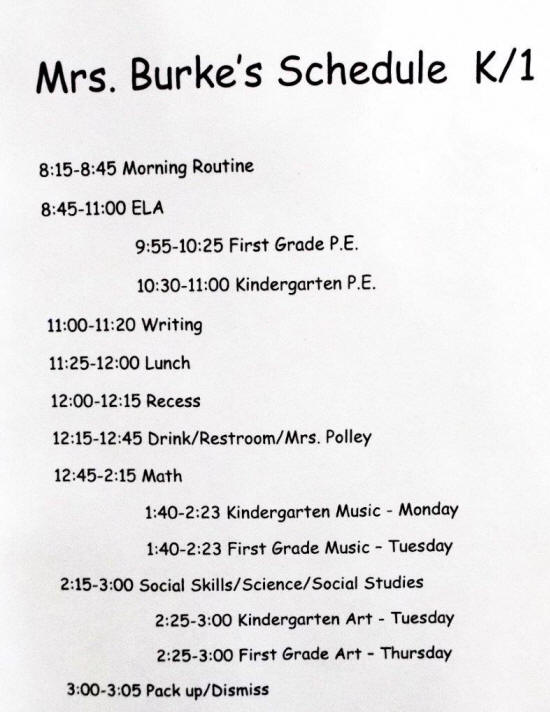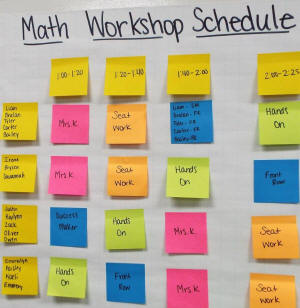|
 Then a couple of weeks before school started, four
students tipped the scale registering for the third grade. While
thinking through how to best meet the needs of the students with the
resources at hand, Mrs. Irwin realized this presented an interesting
opportunity. Then a couple of weeks before school started, four
students tipped the scale registering for the third grade. While
thinking through how to best meet the needs of the students with the
resources at hand, Mrs. Irwin realized this presented an interesting
opportunity.
Relieving each of the four classes of a portion of its students and
creating two blended classes became the plan. It took an intense
amount of last minute work, but the plans came together.
C-EL had two teachers with multi-grade experience and both loved the
idea of teaching a blended class.
The next step was to divide the groups and to contact the parents of
the proposed blended classes. The parents were fully supportive with
only one respectfully declining, Mrs. Irwin said.
Mrs. Kerry Burke agreed to teach K-1 with eight kindergarteners and
seven first-graders. Mrs. Whitney Kessinger would take a class of
eight second-graders and 10 third-graders. This relieved class sizes
for all four single-grade classes.

All six of the classes, single-grade and blended, have the same
daily schedule for reading, writing, math; and a segment of social
skills, science, or social studies.

Teaching the core subjects in a blended class
Both Mrs. Burke and Mrs. Kessinger say that their blended classes
require more labor for preparation than a single-grade class.
Both blended classroom teachers make a presentation for each
subject. Sometimes the K-1 teacher needs to make more than one
presentation to target the varying levels of the students.
After subject presentations the students break into their work
groups.


Mrs. Irwin explains charts are created, one for
reading and one for math with student work-groups. The student names
in the groups change as each student progresses.

Progress over the year
At the start of the school year the differences between the incoming
kindergarten and first grade students are wider. Kindergartners come
in not able to read or write, less mature, and not familiar with
rules and protocols in a classroom. But that quickly changes Mrs.
Burke says, they quickly develop reading and writing skills, and
behaviors are modeled by the older students. The differences between
the two age groups narrowed rapidly and everything got easier for
everyone as the younger students began working more independently,
she said.
What is important to teaching this group, Mrs. Burke says, is "I
have to have a paper for each presentation, know where it’s at [the
paper], and be ready. I have to be very, very organized and have a
plan from the time the bell rings in the morning to the time the
bell rings in the afternoon."
She says, "It's a lot of work, but it is very rewarding." As she
goes to bed at night she often finds herself thinking of class the
next day because she knows how important it is to ready.
Illustrating how quickly the daily experience changes as the year
progresses and the some of the differences of the blended class,
Mrs. Burke said, "When the kindergartners come in they are not
reading, and now they love to come in and sit in their comfy chairs
and read." She adds, "It's really nice to see the older ones reading
to the younger ones. I'd guess to someone just coming in, it might
seem a little noisier, but the students are so engaged they don't
notice."
Mrs. Kessinger reflected on the experience this year and said one of
the big adjustments for the teachers is the schedule. They teach a
subject to their class, the students work in groups, and then it is
time for half of the students to go out to do something with their
grade level.
Students are always coming and going. Smiling she says, "You are
always left with someone in your room." At those times, the students
feel like this is their "special time." She laughs again, "You go
from a class of 18 and for the next period you have just eight, and
the feeling is ‘Holy cow, we can do so much, yeah, let's do it!’"
Mrs. Burke adds in that the quality of a small group in those times
is "so special, you get so much done. It's incredible."
[to top of second column] |

Socially
Between the four primary subjects are periods where the blended
class students leave their classroom to join their grade-level
classmates for PE, art or music - kindergarteners join the other
kindergarteners, first graders go with first graders, and so on.
Mrs. Irwin explained that it is designed that way "because we want
our third graders to be with third graders as much as possible" and
the same for the other grades. This enables the students to maintain
relationships with their same-age peers. Most students choose
friends the same age, so best friends can be with their best friends
portions of each day.
All the K-3 students enjoy lunch and recesses together. This year
there have been some interesting social dynamics observed when all
grade levels are together. There are more interactions between age
groups, more friendships that bridge age gaps.
The teachers and Mrs. Irwin have noticed that students are more
helpful, concerned and protective of one another. They will more
often stand-up for students of other ages.
What do the blended classroom teachers have to say as the year is
drawing nearer to completion?
Mrs. Burke's says of her kindergarten/first-graders, "It is just
wonderful to see kindergartners learning from the first-graders.
The first-graders are role models: they know the rules and
procedures. For the kindergartners it is easier to just fall in line
when you have someone who knows how demonstrating it.

The program/schedule allows reaching students each day "right where
they are at," Mrs. Burke says. By example, when it comes to reading
she splits her students into two groups. While one group is sent to
the library to work on their own, it allows her the time to work
with those who might be struggling, so they do not become
frustrated.
Students who are advanced in learning move quickly and they are not
bored.
Burke observed another benefit to the accelerated students: they
stay working in their own room with familiar classmates, but work in
a group at their level. They might otherwise have to go to another
classroom for a subject. There is an intimidation factor going into
a classroom of other older students.
She emphasizes, "It allows all students no matter where they are (in
capability), to be challenged, excited and engaged in learning
because it is meeting them right where they are at."
Student to student help
Time and again in the blended environment, Mrs. Burke sees "those
who have caught on to something are automatically helping those who
didn't get it." Students see "Oh, she's struggling," and respond "I
will help her." Both teachers are strongly impressed seeing help
that is offered to classmates without being asked. The students "are
just very willing to work together."
Socially
Mrs. Kessinger observed that socially, these students make a lot of
gains that they would not normally make in a regular classroom. They
are exposed to kids who are more mature than themselves and less
mature, but maturity isn't always by age. Sometimes her second
graders are more mature than third graders "and they served as a
role model." It's also good to see relationships form where a second
grader and third grader become best friends, and that wouldn't
happen if they weren't in the same class.
Both blended classroom teachers are energetic, enthusiastic and
their deep passion for teaching shines through. Clearly supportive
of the blended classroom, they say they've seen tremendous growth in
their students academically and socially. Each admits it is more
work, but both laugh and say, "It's a lot of fun. Yeah!"
Mrs. Irwin said that students at C-EL are tested three times a year
for their progress. The blended class students are doing well.

When this year comes to an end, each student in a blended class will
move up to the next grade level, as normal if ready - kindergartners
to first grade and second-graders to third.
Will there be blended classes next year at C-EL?
She smiles and says, "It depends on what the registration numbers
hold."
|